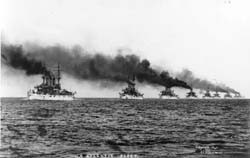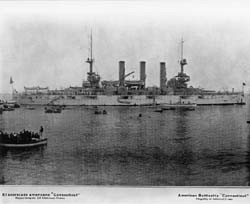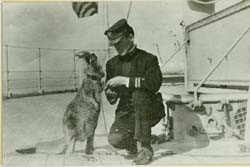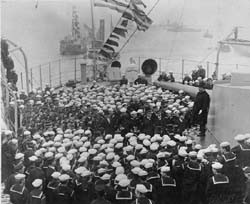History Blog
 |
| Artwork of The Great White Fleet with their powerful white bodies and gilded front |
In July of 1907, President Theodore Roosevelt issued sixteen battleships to travel around the world. These sixteen battleships came from the U.S. Atlantic Fleet. The Great White fleet was called The Great White Fleet because all 16 of the battleships were painted white. This was mainly just for "visual appeal and not of naval necessity."
On December 16th of 1907 The Great White Fleet departs from Hampton Roads, Virginia, and travels south. All the way down to, and around, South America. When the journey first started, only few high ranking officials knew what the task at hand was. Not even Roosevelt's cabinet knew he was sending them around the world. He didn't tell them and other because it would have been opposed. They thought it was a training exercise where the ships would travel from the East Coast to the West Coast.
 |
| The Great White Fleet departing from Hampton Roads (Two ships from far left to right are USS Kansas and USS Vermont) |
 |
| The USS. Connecticut in Callao, Peru in 1907 |
On May 6th, 1908, The Great White Fleet completes its trip around South American and arrives in San Francisco, California. Thousands were there to greet them. There was also a two day long ball at the Fairmont Hotel where, at the time, dinner was $10. Nowadays that would be around $263.16. The people there too greet them and celebrate helped out the sailors who didn't have enough money for a hotel room by pitching tents for them in Jefferson Square and Portsmouth Square.
On July 7th, 1908, The Great White Fleet leaves from San Francisco to travel across the Pacific to Eastern Asia. It makes several stops along the way to refuel and rest. Some of these stops include Hawaii, New Zealand, Australia, the Philippines, Japan, and finally, China. On July 16th they arrived in Hawaii, where they stayed for 6 days at Pearl Harbor. On August 20th they arrived in Sydney, Australia. There were more than 250,000 people there to welcome them. Some of them had stayed up all night so they would not miss their arrival. They stayed there for 8 days then headed out for the Philippines.
 |
| Lt. John E. Lewis with a kangaroo, aboard the USS. Connecticut, presented by the citizens of Sydney |
 |
| Postcard of The Great White Fleet from Japan |
On the first of December in 1908, a little under one year since its departure, The Great White Fleet leaves the Philippines to continue on it's journey around the globe. It doesn't make many more stops before returning to the U.S. though. It's first stop after the Philippines is in Sri Lanka, off the coast of India. Sri Lanka was known as Ceylon at the time because the British ruled then. The next stop was in Egypt. Then in Italy, and finally, in one of the most southern parts of Spain, Gibraltar.
On February 22nd, 1909, The Great White Fleet returns to Hampton Roads, Virginia, which completes its travel around the world in just over 14 months. The purpose of this journey was "for the purposes of generating international goodwill, testing naval readiness and impressing world powers with American might." This trip helped the U.S. learn a lot about the necessity of Naval Bases around the world, steam boat formation, and also boosted the morale of the U.S. Navy. 90% of the stops they made were for resupplying and purchasing more coal to continue on their way. It also showed that the U.S. was ready to take on the world and prove that they were ready to be a world superpower.
 |
| President Roosevelt addressing those aboard the USS. Connecticut after their arrival back in Hampton Roads. |